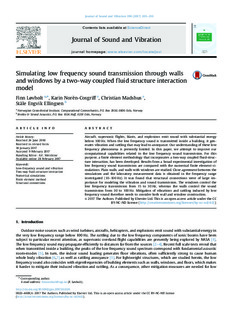Simulating low frequency sound transmission through walls and windows by a two-way coupled fluid structure interaction model
Peer reviewed, Journal article
Date
2017Metadata
Show full item recordCollections
- NGI articles [1067]
Abstract
Aircraft, supersonic flights, blasts, and explosions emit sound with substantial energy below 100 Hz. When the low frequency sound is transmitted inside a building, it generates vibration and rattling that may lead to annoyance. Our understanding of these low frequency phenomena is presently limited. In this paper, we attempt to improve our computational capabilities related to the low frequency sound transmission. For this purpose, a finite element methodology that incorporates a two-way coupled fluid-structure interaction, has been developed. Results from a broad experimental investigation of low frequency sound transmission are compared with the numerical finite element simulations. Plain walls, and walls with windows are studied. Close agreement between the simulations and the laboratory measurement data is obtained in the frequency range investigated (10–100 Hz). It was found that structural connections were of large importance for modeling the vibration and sound transmission. The windows control the low frequency transmission from 15 to 30 Hz, whereas the walls control the sound transmission from 30 to 100 Hz. Mitigation of vibrations and rattling induced by low frequency sound therefore needs to consider both wall and window construction.
